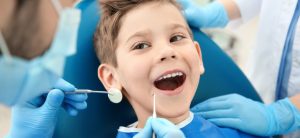Every day should be about children’s dental health – not just the month of February.
We teach children to read, ride a bike, and say thank you, but we shouldn’t stop there. Teaching and modeling good oral health habits such as brushing, flossing, and establishing a dental home are just as important. Unfortunately, for a lot of parents, getting kids to brush and floss their teeth is like … well, like pulling teeth. But if we want to protect our children from having their teeth actually pulled at some point in their lives, we must show them the ins and outs of proper oral hygiene and how it relates to their overall health.
We often think of brushing and flossing our teeth similarly to how we view other self-grooming habits, i.e., putting on deodorant, combing our hair, but it’s much more than that. When we practice good oral hygiene habits, we are in-essence practicing good infection control. When you properly brush, floss, and deplaque your tongue, you are reducing the oral biofilm (bacterial count) in your mouth; thus, reducing your chance of developing dental decay (cavities), and gum disease. Not only are you reducing your chances of developing cavities, but we know from the science, you are also lowering your risk for developing heart disease and diabetes. And while science is helpful in understanding this oral-systemic connection, we can’t lose sight of the fact that dental decay remains the most common, chronic childhood disease.
Sharing this information couldn’t come at a better time as February is National Children’s Dental Health Month (NCDHM). NCDHM serves as a vital reminder for parents and communities to prioritize the oral health of our youngest members, ensuring they have access to necessary preventive and restorative care as well as resources for a healthier future.
In West Virginia, we are making progress to address children’s oral health issues, but there is more to do. A recent survey analyzed the 50 states and D.C. across 25 indicators of dental wellness, including treatment costs, and dentists per capita, to identify where people have the healthiest teeth and gums in the U.S.
Among the findings, West Virginia stood out as a state grappling with challenges in dental care. Ranked 49th in the nation, just above Mississippi and Arkansas, the report reveals a sobering reality: many residents cannot afford necessary dental visits.
Experts say this financial strain is exacerbated by a lack of available dentists—West Virginia is among the states with the lowest ratio of dental professionals per capita, making it difficult for families to receive routine check-ups and treatment.
The 2024 WV Oral Health Report Card reveals only 13% of children ages 1-2 enrolled Medicaid who received a preventive dental care visit. For the 1-20 age group, 41% received one or more preventive dental visits in the last year. Positive findings include 81% of children aged 1-17 have received one or more preventive dental visits in the last year. 62% of third grade students with dental sealants, a protective coating painted on permanent molars, and 91% of the population with access to optimally fluoridated water served by a community water system.
Oral health is a critical part of overall well-being, influencing everything from cavity prevention and gum health to lowering risks for heart disease, diabetes and multiple other systemic diseases. While these numbers signal progress, gaps remain in rural and underserved areas, where residents still face challenges accessing affordable dental care.
Teaching children about good oral hygiene at an early age is vital to keeping them healthy. Establishing a dental home and making oral health an integral part of their regular health regimen helps children get a good start on a lifetime of positive health outcomes. And by developing good habits in one area, it will be easier for them to develop good habits in other areas of their lives.
Continued efforts in dental education, workforce maximization, rural health programs, medical/dental integration efforts and multiple state-level initiatives are crucial to further reducing disparities and ensuring all West Virginians, and especially our children, have access to quality oral healthcare.

